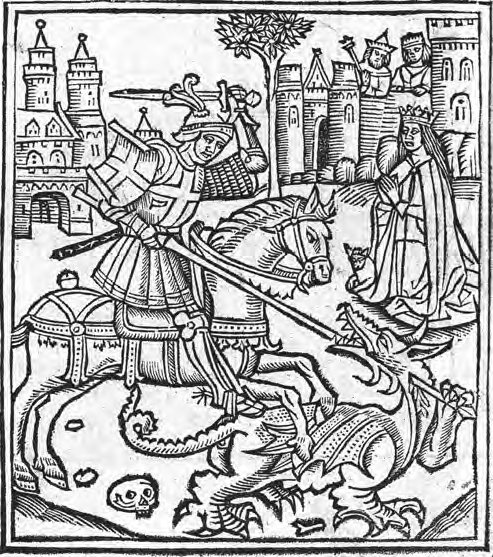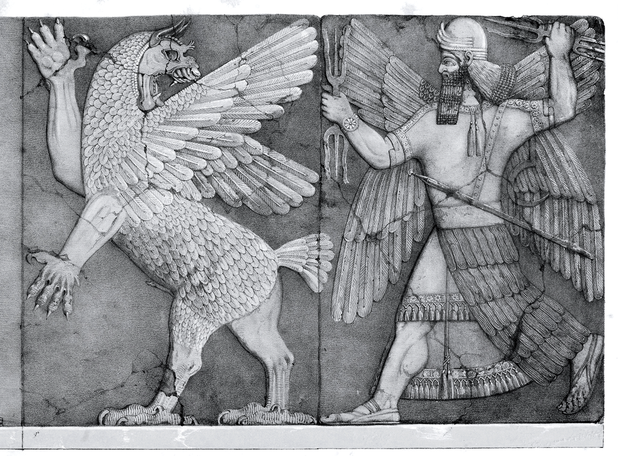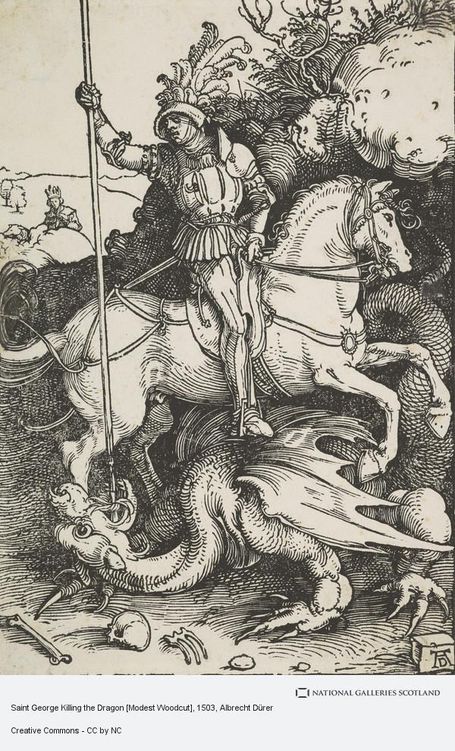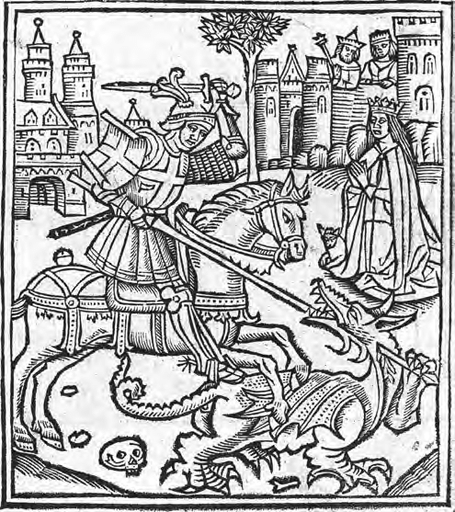
St George and the Dragon Fire
“He may be like Khidir, the green one, who travels the earth in a variety of guises, and by means unknown to you…” (The Sufi’, Salik)
The cult of St George originally derived from the martyrdom of an early Christian. Together with Middle Eastern mysticism, the legend arrived in Britain around the eleventh Century carrying with it a colourful legacy of a draconian cult and fiery gnosis; combining astrology, alchemy, Jewish and Islamic mysticism and merging it with indigenous schools until a truly English patron emerged. In its simplest form, the legend of St George is a quaint fairy tale, a supposed allegory of the triumph of good over evil or, more precisely, virtue over sin.
Al-Khidir , the Green Saint, “verdant”, figures in Islam as an anthropomorphic force of nature whose esoteric knowledge exceeds even Moses’. The prophet has difficulty in accepting the actions of Khidir, who explains that Moses will have no patience with Him or his motivating reason. Khidir supposed to have entered the Underworld with Alexander and is sometimes equated with Elijah and even Aristotle. This green man, an Immortal, travels widely and may have travelled to Britain during the last millennia and settled in the myth of George. Using the Arab name for St George, Al-Khader (Khidir) is a town in Palestine that is built upon a Canaanite settlement. It is renowned for its vineyards and Christians and Muslims attend the celebration of the feast of St George, which is held at the Monastery bearing his name, in early May. Moreover, Khidir is not an archaic or dead spirit but is more like a living god perceived of as being very much alive.
The name of George was really introduced into Britain after the First Crusade and derives from the Greek Georgos meaning literally “earth worker”. It was the twelfth Century English King Richard I, “The Lionheart”, who had a vision of St George with a Red Cross banner that caused crusaders to identify themselves with such a mark. This King may be the representative of a line of divine Kings identified in the Plantagenet line by Evan John Jones and Doreen Valiente in Witchcraft: A Tradition Renewed. The idea that the Plantagenet Kings protected an old line of divine Kings within the old faith possibly comes from Margaret Murray but is hinted at in many other writings, together with the idea that the horned God was introduced from Eastern influence around the crusader period. However we may consider that, if the Lionheart is such a King or not, certain Middle Eastern mysticism could have legitimately entered native myth around this time.
“By his spirit, the heavens were claimed, His hand has pierced the Pole Serpent.” (Job 26:13)
The Pole Serpent is the Leviathan, the dragon that encircles the ecliptic Pole Star and upon which hang the heavens. The ecliptic pole is calculated based upon the path of the sun throughout the year and the earth’s orbit and, based upon this measurement, the Pole Star does not always refer to the celestial Polaris. In simple terms, the ecliptic is the means by which the Equinoxes and Solstices are equated based upon the orbit of the earth and the positioning of the sun in the astrological sphere. In the ancient world, the constellation Draco surrounds the pole star and has a star in each of the Zodiacal positions tracing a path through the year.
“The Teli in the universe is like a king on his throne” (Sefer Yetzirah 6:3)
The Teli in this passage is often identified with Draco, the constellation that has the ecliptic pole at the point of its tail and a star in each sign of the Zodiac. In this instance, Draco was considered a false idol and identified with Baal. The ecliptic Draco is among the few constellations that openly resemble the animal or totem they are called after and, at the heart of this beast lies the constellation Ursa Minor, around which the dragon is coiled.
Mogg Morgan, of the Oxford Golden Dawn Occult Society (OGDOS), in his book Tankhem identifies Ursa Major with the Egyptian constellation Meskhetyu, the Bull. Marduk, the Sumerian deity whose name originated from Akkadian meaning “solar calf”, here resembles Ursa Minor, the smaller brother of the Great Bear or Bull. The deity Marduk was associated with vegetation and water and was symbolised by both a dragon and a spade, items which could equally represent the legend of George (“earth worker”).
The two principle constellations of concern to the ancient Egyptians were Orion and Ursa Major. These may have represented the twins Osiris and his murderer Set, who dismembered his brother. Mythology informs us that Isis, His sister and wife, sought out the parts and resurrected Osiris save for his penis, representing his emasculation. Isis then begat Horus who sought to avenge his father’s murder upon Set and a Sacral King legacy is born.
In Medieval Romance, this cycle could be compared to Sir Gawain & The Green Knight, whereby the Green Knight challenges Arthur during the Christmas feast. As the King’s representative, Gawain severs the Green Knight’s head from his torso, but must return to face the same challenge at the next New Year. Clearly, this cycle has been altered from a biannual event to yearly, but the principle could be argued the same. Another legendary figure that is identified with the Great Bear and Draco is Arthur himself, whose name is supposed to refer to Ursa Major, whilst his epithet is the Pendragon – his sacred symbols include the sword, spear and dragon, as well as the chalice.
Speaking of the cyclical sacrifice of Osiris and Set, Mogg Morgan says: “…in the cycle of the year, Osiris [Constellation Orion] is not the only sacrificial victim – whilst at the Summer Solstice Osiris is sacrificed by water, at the winter solstice Seth [Draco] was sacrificed by fire…”
If we identify St George with the constellation Orion, aligning him astrologically with the Mithraic current, he becomes the hero who slays the Bull, that is Ursa Major; a similar legend of the type associated with the patron Saint George. Another constellation, though, becomes more fitting here in the shape of Draco and an ophidian current; Leviathan the Pole Serpent, with whom the Plough are in a cyclical dance, a chase of hunter and hunted, the roles shifting with the celestial tide and visible in the night sky.
Thelemic Nuit is comparable to the Chaldean Cosmic Soul, Hekate, “Lady of the Starry Heaven”. In Egyptian mythology, she is Nut, the Goddess of the sky, meaning “night”. Compare this to Robert Cochrane’s Basic Structure of the Craft
“In the Beginning there was only Night, and she was alone. Being was absolute, movement was there none.”
Night has associations with the moon as the mediator between the upper realm and lower and represents the element air standing between the spheres of earth and the heavens. Circling on either side is lunar water and solar fire, perpetually turning and pursuing each other around the axis mundi, the pole star, as night and day, hunting and being hunted as the earth progresses around Helios. Georgios, then, is the waters of the moon, ever moving upon his ‘spirited’ steed towards the fire of the sun, “From the sun freely flowing, the moon fetches light”, and the serpent continues to spiral. Taliesin asked: “Which was first, is it darkness, is it light?”. So Night is comparable with the celestial tapestry, the robe of the Cosmos whilst simultaneously being the axial point of rotation. Her twins are in the Cainite myth, paralleled with Sethian currents, later confounded with the legend of the martyred St George and his mythic dragon, ever chasing each other around the celestial plane like young stag perpetually locking horns with King Stag.
In the Sefer Yetzirah, the basic triad is found in air, water and fire, the mystery of the Three Elemental Mothers and the letters Alef, Mem and Shin. These three letters may be permuted in six different ways, or 6, 6, 6 the number of the Beast.
“…here is Wisdom. Let him that hath Understanding count the number of the beast: For it is the number of a man…”.
As a curious aside, the Book of Revelations, from which this quote comes, was written during the reign of Diocletian and the Beast is believed by Scholars to be a sardonic reference to a Roman Emperor of the age, either Diocletian or Nero. Both Emperors put a large number of Christians to death, amongst whom was George, later canonised. Indeed, in early iconography, George is depicted slaying a man that may be Diocletian long before the dragon of English legend. Important words in the passage from the Book of Revelation are “Wisdom” and “Understanding” and the Kabbalist will be able to place them upon the Tree. If Georgios and Draco are twin sons of the Three Mothers, they are also to be found the Formula of IAO as the twin forces of creation and destruction, the Alpha and Omega.
One Kabbalist technique involves the descent of divine power from Kether to Malkuth and each of the sephiroth between whilst passing through the body. One rendition of this is called the “Flaming Sword”, where the movement zigzags like a lightening bolt from above. This is coupled with the rising serpent energy from Malkuth to Kether where it climbs the tree converse to the bolt of lightening striking downwards like a spear shaft. These two forces represent the descent of God into matter and the ascent or evolution towards union with Godhead – combined it is the essence of creation. Here, the sword or spear is that of St George striking downwards to pierce and awaken the serpentine energy, which ascends toward Gnosis, climbing the tree to the crown of the Goddess of seven stars.
“All things that are of this world belong to him, the star-crossed serpent.”
In this reference, Robert Cochrane, Traditional Witch and late Magister of the Clan of Tubal Cain, infers to his correspondent the meaning of the cauldron and its serpentine association. Many occult schools discuss the serpent in reference to its earth-bound nature, the divinity in the world manifest, bubbling beneath us like ancient volcanic forces waiting to issue forth its lava. This secret fire often resides in caves, hidden in the depths of the earth and is chthonic in nature, found in legend guarding treasured of gold, alchemical enlightenment. Opposite to the fire drake is the water drake, both located by place names that record this mythic beast such as Draycote Waters in Warwickshire.
The dragon of St George is no ordinary serpent but a fire breathing, earth or water dwelling beast. The fiery dragon’s breath is an immolating force and typically virginal female victims attend the legendary monster until the hero, in love with such a Vestal princess, enters the cave that will be his tomb and perhaps his womb. The significance of fire here is relevant to our hero’s quest and George is burned and blinded inside before emerging scorched from the belly of the infernal cave. In actual fact, according to one version, the Saint is born with the dragon emblazoned upon his chest, identifying him with his destiny.
In some schools of thought, Hell represents the realm of ignorance where fire purifies the soul and makes it fit for knowledge. Comparable to many Underworld myths, this world is often where we return before emerging again into the manifest until we are properly prepared to be one with the Godhead and claim our right to the Blood-Royal. The infernal immolating flame of the Underworld purges the self and renders the soul as a vessel that may be filled. While we are consumed with self, how can we be a vessel for anything else?
Among Sufi teaching is fanaa, which roughly translates to mean “annihilation in love”, which signifies the death of self or ego whilst remaining physically alive. Hellfire and descent into the Underworld may be compared with the purging of the self before attaining Gnosis. In the mystery traditions, tales of traversing the Underworld and emerging from the earth abound with the hero somehow reborn to be in the world but not of the world. Another example is found in the story of Jesus who committed an act of self-sacrifice before being placed in a cave from which he emerged as a man of knowledge. Only then could he attain the Kingdom of Heaven – although many believe that he did not physically leave the manifest world but became a deva, an angel or perfected man (Adam Kadamon) who continued to travel and teach. In another rendition, Dionysus also leaves the cave and is “twice-born”, allegorically being initiated in the womb-like earth that had entombed him. Like Jesus, the rites of Dionysus ended with his body being consumed akin to a sacrificial meal, a Housel or eucharist.
The word annihilate is interesting and deserves some comment. Coming from Latin, it indicates a return to a state of nothingness and in both Sufi and Kabbalist thought this state could be equated with infinite divinity, ain soph, the origin of all creation. Therefore, a complete unity with nothingness is a realisation of the divine.
The journey of George, then, into the cave is symbolical of his entering into the Grail King’s barrow. It is not a literal dragon that is slain but the hero’s attachment to ego and the flames that billow forth from the tomblike hill is the light that comes with sacrifice. It is Love that delivers George into the lair of the serpent and it is the dragon’s breath that purifies the hero who leaves in a shining new mantle having discarded his old armour as a serpent sheds its skin.
“The true lover finds light only if, like a candle, he is his own fuel, consuming himself.” Attar of Nishapur


